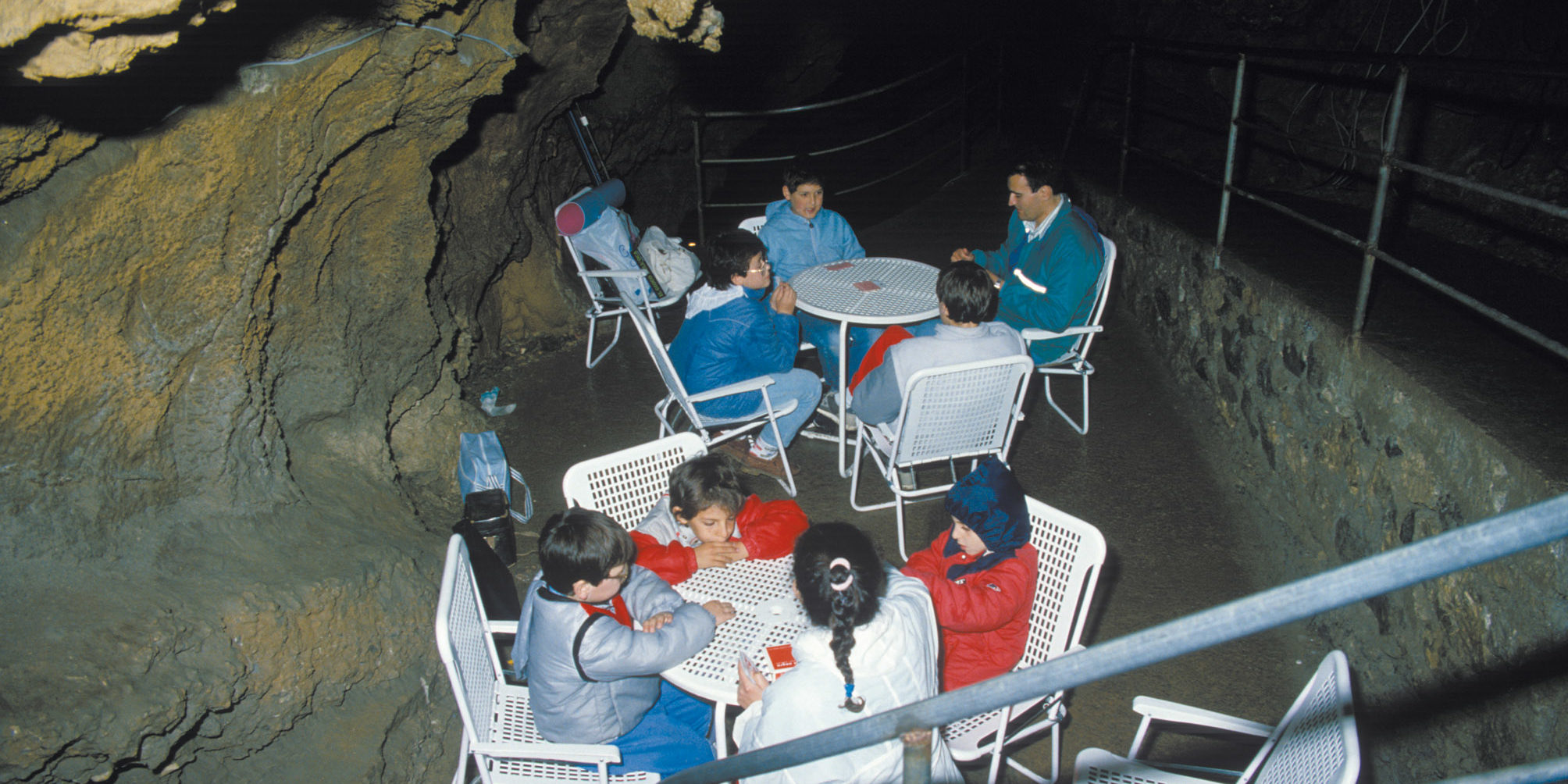English below.
Durante la seconda guerra mondiale la cittadina di Ennepetal, situata in Renania, fu ripetutamente bombardata dalle forze alleate. La popolazione trovò rifugio nella vicina Kluterthohle, una grotta labirintica a sviluppo orizzontale situata nell’area urbana. La frequenza degli attacchi fu tale da convincere alcuni rifugiati a trasferire le masserizie essenziali nella grotta, dove dimorarono provvisoriamente aspettando che finissero le ostilità. Finita la guerra si notò che tutti i rifugiati che in precedenza soffrivano di alcune patologie dell’apparato respiratorio erano guarite o, comunque, avevano riportato sensibili miglioramenti.
Si occupò del caso il prof. Carl Hermann Spannagel che mise a punto un processo di cura noto come speleoterapia, trasformando la Kluterthohle in una clinica sotterranea per la cura dell’asma e di altre malattie riguardanti la respirazione.
Sul finire degli anni ’70 il prof. Spannagel riscontrò nel microclima della Grotta del Vento alcuni parametri molto simili a quelli della Kluterthohle.
Negli anni ’80 la facoltà di Medicina dell’Università di Pisa, in collaborazione con la Federzione Speleologica Toscana, organizzò nella Grotta del Vento una lunga sperimentazione su pazienti affetti da asma bronchiale sia cronica che allergica, con risultati molto incoraggianti, soprattutto sui bambini e sugli adolescenti.
Il prof. Giovanni Agostini, che dirigeva l’esperimento, nel corso di un congresso dichiarò che la speleoterapia non era “una” cura ma “la” cura di queste patologie: l’unica veramente efficace e priva dei gravi effetti collaterali che possono derivare dall’uso prolungato dei cortisonici.

Un momento di relax durante una seduta speleoterapica
A moment of relax during a session of speleotherapy
I principi attivi sono da ricercarsi nella qualità dell’aria, assolutamente priva di pollini, spore o polveri (ogni particella solida divenendo un nucleo di condensazione, viene abbattuta al suolo entro i primi cento metri) e ricca di umidità relativa (attorno al 100%), oltre che di un minutissimo aerosol contenente ioni negativi di sodio, potassio, magnesio e calcio. È soprattutto la presenza di quest’ultimo elemento a potenziare le difese dell’organismo contro gli allergeni. Da non sottovalutare inoltre l’abbondanza di anidride carbonica, che con l’acqua dell’aerosol forma acido carbonico, esplicando un notevole potere batteriostatico e, talvolta, battericida.

Sotto controllo medico viene effettuata una spirometria
Undergoing spirometry under medical supervision
Ma questi elementi non sono sufficienti a spiegare gli effetti curativi, in quanto è stato constatato che non tutte le grotte aventi, almeno apparentemente, le stesse caratteristiche microclimatiche, possiedono effetti terapeutici. È stato altresì accertato che tutti i tentativi di creare artificialmente degli ambienti (tipo camere iperbariche), con un microclima identico a quello delle più famose grotte curative non hanno dato risultati degni di nota.
Molto praticata in Germania e nei paesi dell’est europeo, in Italia la speleoterapia viene praticata solo a Predoi, in provincia di Bolzano, dove una miniera abbandonata, nella quale si è formato un microclima simile a quello delle grotte naturali, è stata attrezzata con successo per questo tipo di cura, che pare abbia effetti benefici anche su alcune malattie della pelle, sull’ipertensione e sulla depressione.
SPELEOTHERAPY
Duing the second world war the little town of Ennepetal, situated in Renania, was repeatedly bombed by the allied forces. The population found refuge in the nearby Kluterthohle, a labyrinth-like cave with a horizontal development situated in the urban area. The attacks were so frequent that some people decided to take refuge in the cave and bring with them all the essential provisions and they stayed there temporarily waiting for the hostility to end. When the war was finished it was noted that all the refugees who had previously suffered from some pathologies of the respiratory system were cured or, however, considerably better.
The professor Carl Hermann Spannagel took charge of the case and developed a treatment known as speleotherapy, transforming the Kluterthohle into an underground clinic for the treatment of as ma and other respiratory illnesses.
Around the end of the 70’s Prof. Spannagel noticed in the micro climate of the Grotta del Vento some parametres very similar to that of the Kluterthohle.
In the 80’s the faculty of medicine of the University of Pisa, in collaboration with the Tuscan Speleological Federation, organized in the Grotta del Vento a long experiment with patients suffering from bronchial asma both chronic and allergic, with very encouraging results, especially with children and adolescents.
Prof. Giovanni Agostini, who directed the experiment, during a congress declared that speleotherapy was not “a” cure but “the” cure for these pathologies: the only one truly effective and without the serious side effects that can be caused by a prolonged use of cortisone.
The main active ingredients can be found in the quality of the air, absolutely free of pollen, spores or dust (every solid particle becoming a nucleus of condensation, is brought to the ground within the first hundred metres) and rich in relative humidity (around 100%), as well as a minute aerosol containing negative ions of sodium, potassium, magnesium and calcium. It is mostly the presence of the latter which boosts the defences of our organism against allergens. The abundant presence of carbon dioxide should not be underestimated, which with the water from the aerosol forms carbonic acid, creating a considerable bacteriostatic action and, sometimes bactericidal.
But these elements are not sufficient to explain the curing effects, since it has been noted that not all caves having, at least apparently, the same characteristics of the micro climate, possess therapeutic effects. It has also been established that all attempts to create artificially these environmemts (hyperbaric chambers), with an identical micro climate of the most famous caves for treatment do not have results worth noting.
Practiced a lot in Germany and eastern European countries, in Italy speleotherapy is only practiced in Predoi, in the province of Bolzano, where an abandoned mine, where a very similar micro climate to that of natural caves has formed, has been successfully equipped for this type of treatment, which seems to have beneficial effects also on some types of skin disorders, hypertension and depression.









Gentile Direzione, come referente scientifico di Speleoterapia per l’associazione turistica della Valle Aurina e del Comune di Predoi mi complimento per la descrizione chiara e dettagliata su questa particolare forma di climatoterapia.
Spero che sempre più persone possano beneficiare degli effetti positivi della speleoterapia sulla salute respiratoria .
Cordiali saluti
Vincenzo Di Spazio